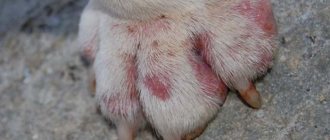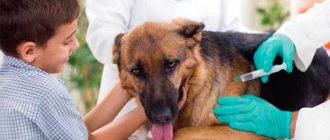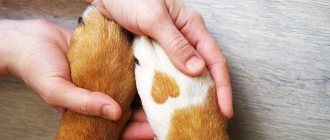Common Causes of Paw Swelling
Below we will explain in detail what the most common causes of inflammation of the limbs are. Before we begin, we need to note that all causes require veterinary treatment. They are:
- abscesses,
- joint injuries,
- calluses,
- fractures,
- swelling,
- tumors.
I suggest you take a closer look at each of these reasons. Below, read in detail and briefly about all six causes of paw swelling in dogs.
Diseases
Swelling of the paw or tumor is a consequence of the development of any disease not associated with external causes. Tumors can have different shapes, densities, and locations. You can get rid of them only by curing the underlying disease.
Therefore, if your dog has a swollen paw and you are sure that there were no injuries, you should look for the disease. Most often, animals develop edema and tumors due to the following health problems:
- vascular diseases;
- articular hygroma (a formation that occurs more often in the elbow joints, in which fluid accumulates);
- benign and malignant neoplasms (tumor in the form of a lump, painless, with clearly defined edges);
- pathologies of the kidneys and liver with impaired lymph outflow (tumors are soft, do not have clear boundaries, swelling is stronger in the lower part of the limb);
- arthritis, arthrosis, ingrown claws;
- pododermatitis (an inflammatory process associated with decreased immunity and manifested by swelling of the fingertips and the spaces between them);
- vitamin deficiency and lack of essential microelements in food (joints become swollen, more common in German shepherds);
- allergies to dust or chemicals in the soil.
Only in a veterinary clinic will you be able to find out the exact cause and choose an effective treatment after a thorough examination and examination.
Pet diseases are always difficult to diagnose. If a dog's paw is swollen, it could be a mechanical injury, a bone fracture, or a disease of the internal organs.
After an injection and other medical procedures, swelling may also appear. This symptom cannot be ignored; it is important to identify the factors that provoke swelling.
Abscesses
An abscess is a collection of pus under the skin. It can appear after an injury caused by a bite, scratch, or any foreign body that has become stuck and lodged in the paw.
In these cases, the skin appears healed, but an infection has developed underneath and accumulates pus. This is called an abscess. It usually occurs in one limb.
Sometimes the abscess opens and pus begins to ooze out. However, it also happens that the pus does not come out completely. In these cases, the veterinarian will have to drain him, thoroughly clean the area, and prescribe medications if necessary.
Joint injuries
Sprains and strains can happen at any age and for reasons such as poor movement, a fall or a blow. There are also some diseases, such as borreliosis, that include joint swelling among the symptoms. But, in any case, this inflammation is not always visible.
In fact, a common sign would be lameness and more or less obvious pain.
Additionally, older dogs may have degenerative joint diseases that cause stiffness, pain, and inflammation. They may not heal, but quality of life is improved and pain is reduced with treatment recommendations. Veterinary evaluation is always necessary to determine the cause.
Causes
Joint diseases are observed in dogs of various breeds and age groups. Representatives of large “heavy” breeds (mastiffs, St. Bernards, Great Danes, Alabais, Caucasians) are at risk.
A large load on the bones, an uneven growth rate, especially in representatives of fast-growing, large-scale production, provoke all sorts of disorders in the functioning of the musculoskeletal system, which is especially dangerous for large dogs that live in small apartments . Animals do not receive proper exercise. With an unbalanced diet, dogs’ bodies do not receive the required amounts of macro-microelements, vitamins, and amino acids, which also negatively affects the condition of muscle, bone structures, and joints. This leads to various injuries and disorders.
Hip dysplasia is most common in puppies. Dogs of small decorative breeds are less susceptible to pathologies of the musculoskeletal system.
Possible reasons:
- penetrating deep wounds, severe injuries, bruises;
- open, closed mechanical damage, sprains, dislocations;
- viral-bacterial diseases, parasitic diseases;
- congenital pathologies of the musculoskeletal system (Wobbler syndrome);
- weakening of resistance, decreased immunity;
- excessive physical overload;
- age-related changes in joint structures;
- genetic, breed predisposition;
- endocrine, hormonal disorders (overweight, obesity);
- metabolic failures, hypovitaminosis;
- abnormal development of the dog;
- autoimmune pathologies;
- prolonged hypothermia;
- acquired, congenital pathologies of muscles and tendons.
Purulent inflammation of the joints in dogs (purulent septic synovitis) develops due to the penetration of pyogenic pathogenic microflora (streptostaphylococci). This pathology is diagnosed against the background of viral, bacterial infections, diseases, as well as in emaciated, weakened animals. Arthritis also often occurs if the composition of the intra-articular fluid has changed, with severe damage to the cartilage tissue.
Deformable inflammation of the joints occurs after severe injuries, damage, dislocations. The pathology develops against the background of hypovitaminosis, arthrosis, joint dysplasia, due to disruption of metabolic processes in the body of animals. Often noted in representatives of large, giant, working breeds, and in older animals.
Calluses on paws in dogs
Also called herpes. They are grayish in color without hardness with folds that appear where the bone presses against the ground when it is a hard surface. It most often affects heavy dogs or those living in kennels with concrete floors .
The affected area is usually the elbow joint, then the joints, and buttocks. They can become infected and require veterinary treatment. To prevent herpes, you need to place your dog on soft surfaces.
It is the inflammation of the bursa, sacs filled with synovial fluid, that protect the joints. They may appear on one or both elbows. They usually don't hurt or affect movement, but like calluses, they can become infected. The veterinarian will treat them with a bandage, drainage, surgery, or medications.
Treatment of various types of body edema at home
Whatever the edema, treatment procedures, medications, course of treatment should be prescribed by a doctor based on the results of clinical and laboratory tests.
Front and hind legs
For swelling of the front and hind legs, biochemical blood tests are necessary. There is no need to apply compresses, wraps, poultices, ice application and other procedures if the swelling is not caused by local exposure (frostbite, burns). If the swelling is caused by paresis or paralysis, if nerve conduction is disrupted, then the tissue will be renewed gradually.
In case of joint swelling, bruises, sprains, it is necessary to apply cold (only in the first 1-2 hours), a tight bandage and ensure rest.
Swelling of the head and muzzle: eyes, cheeks, nose, lips, tongue
Swelling of the head and muzzle: eyes, cheeks, nose, lips, tongue can occur due to allergic reactions. In this case, the animal can be given an injection of diphenhydramine, Tavegil or Suprastin. If the swelling is due to a bee or other insect sting, anoint the bite site with iodine and apply ice.
If the cause of edema is a mite that causes demodicosis, then it is impossible to do without an accurate diagnosis. If the diagnosis is confirmed, liniment “Demos”, drugs “Decta”, “Ivermect-spray” will be effective.
Necks
If your neck swells, you need to rush to the doctor, as disturbances in the respiratory system are possible. There is no point in applying treatment on your own. The best principle is to do no harm.
Outer ear
Swelling of the outer ear and pinna may be associated with insect bites. If such a case is isolated, then it is enough to treat the bite site with an alcohol tincture of iodine.
With otodectosis (ear mites) in a chronic form, there may also be a reaction and swelling. In this case, you should use Amidel-gel, Dekta, Amit.
Testicles, scrotum or loops
Inflammation of the testicle (orchitis) in a male dog will be manifested not only by swelling of the scrotum, but also by pain, increased local and general temperature. The dog will have difficulty moving its limbs. The process is very painful and to ease the course before a doctor’s examination, you can use analgesics and wipe the scrotum with camphor oil.
Swelling of the loop in a bitch is observed during sexual arousal and is considered an absolutely normal phenomenon.
If the vagina and vulva are ruptured during childbirth, severe swelling will occur. To prevent ruptures, it is necessary to introduce mucous substances when the birth canal is dry and not to begin obstetrics until the position of the puppies is corrected in case of pathological presentation or volvulus.
Belly
Swelling of the abdomen cannot be ignored. However, you don’t need to provide help yourself. A timely visit to the clinic and diagnostic tests will help to find out the cause of the occurrence.
Abdominal edema is especially dangerous if its appearance is due to unknown causes.
Tail
Tail swelling is a rare occurrence unless mechanical compression occurs. But the subcaudal space can suffer from swelling due to inflammation of the paraanal glands.
If the dog is predisposed to clogging of the glands, then it is necessary to carry out timely cleaning to avoid pathological phenomena. In case of primary inflammation, an urgent visit to a doctor is necessary to provide assistance.
Leg fractures
When a bone breaks, it can result in an open or closed fracture. In the first case, we will see a wound, and in the second, the skin will remain intact. In both we can detect inflammation. Limb fractures are caused by blows, a strong blow, or a fall from a great height.
In these cases, the dog is likely to suffer more damage, such as internal bleeding, organ trauma, and the like. Therefore, a thorough check by a veterinarian is required. You should see a professional for evaluation, management, and treatment of your pain. This may be immobilization or surgery.
Edema in dogs
Edema is an accumulation of fluid that becomes visible in areas such as the abdomen or limbs. These accumulations occur as a consequence of certain diseases, such as renal failure, congestive heart failure.
Edema occurs due to problems with fluid removal, poor diet, or low levels of protein in the blood. Swelling can affect all four legs. It requires veterinary treatment because the cause must be determined and specific treatment prescribed.
Diuretics are usually prescribed to help remove excess fluid. These are medications that should always be used under the supervision of a veterinarian.
The dog fell on its hind legs and had a swollen belly
Angela
1531 views
November 14, 2019
Hello! My cable East European Shepherd turned 14 years old in August. He is already deaf and blind, until you shout in his ear, he doesn’t hear, he’s afraid to go into the rooms. He comes into the kitchen and is then afraid to go out, so we help him so that he doesn’t crash into the door frame. About a year ago he started having problems with his hind legs - he began to walk with difficulty, but nevertheless he did not refuse walks, he asked for them. Sometimes he could lie down, crap himself, and continue to lie there as if nothing had happened. We understand that the dog is old, we don’t scold him too much. I live in a rural area, the nearest veterinary clinic is 80 km away. along the river by boat, so it is not possible to take the dog to the doctors. I contacted specialists in Khabarovsk for advice, and they told me that the dog eats, drinks, walks, and is basically healthy. We can prescribe drugs that will put him back on his feet, but will shorten his life, because... these drugs seriously damage the internal organs, especially since the dog is old, so choose - let him still live with sore paws, or we put him on his paws, but we don’t know how long he will last. Of course I chose the first one. But for the last week he has generally fallen on his paws, takes two steps to a bowl of water, drinks, and then falls. Then after a while he goes back to the bed. For the last three days we have been trying to take him outside to the toilet, it is useless, although our house is private, you go through the corridor and that’s it - that’s the street. Until he starts pooping or urinating under himself, then he can be kicked out, he goes in a hurry, and either urine pours out of him or poop falls out. It turns out that he goes to the big one once a day and once to the small one, apparently, today he went to the small one twice. And one more thing - his feces are reddish in color, like grains, not liquid, but not solid either. Urine is deep yellow. He refuses his food - they cooked him porridge, wheat porridge with fish or stew. For the last week he has been eating only boiled sausage, stewed meat, boiled fish, boiled meat, raw minced meatballs with the addition of boiled carrots, a little raw cabbage, egg yolk and oatmeal, sometimes a raw egg, 1.5% milk. But is this food for a large dog? But that's half the trouble. For three days his stomach has been swollen and tight. I feel it, it doesn’t seem to hurt him, he doesn’t react. And he's breathing heavily. There are no vaccinations, it was dewormed a year and a half ago, I read that deworming can be dangerous for an old dog. Tell me why my dog’s stomach may be swollen and whether it’s possible to at least put him on his hind legs a little. What can I give him to drink, and if possible, write some medications for both dogs and humans, I don’t know when I’ll get out into the city, we’re in the thaw season now. Maybe the pharmacy will at least have something. And what to do about his involuntary urination, maybe eat dog diapers? Please answer me, I am very worried about my Ymir. Really looking forward to your reply.
Age:
47
The question is closed
Tumors in dogs
Tumors are abnormal growths of cells that can occur in various parts of the body. Some are benign and others are malignant and have the ability to spread to other places in a process called metastasis.
They can grow in a variety of cells, including bone cells, causing inflammation in the affected limb. Whenever we suspect the presence of a tumor, it is important to go to the veterinarian as soon as possible, as it is necessary to obtain an early diagnosis.
This is what guarantees the best chance of success in treatment. To know whether it is cancer or not, the veterinarian will remove the tumor or take a sample to send to the laboratory. In this way, basic information is obtained to identify the type of cancer and the extent to which it is detected. Treatment and prognosis depend on this.
Prevention of tumors
To avoid damage, the dog’s diet is enriched with calcium, the animal is walked in safe places where there is no construction debris or broken glass.
Control
At home and on the street, the pet must be within the owner’s field of vision. A person can always prevent injury to a dog or quickly respond if the animal does injure a limb.
Training
Dog training begins at an early age. An adult animal must strictly follow all orders of the owner.











